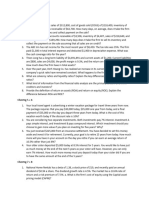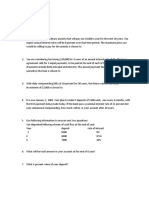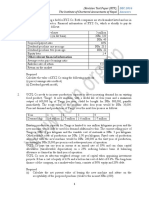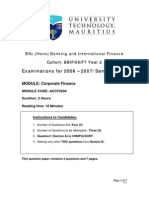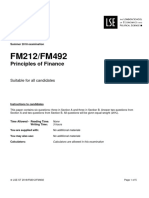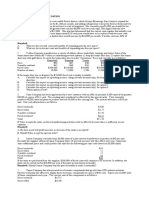0 ratings0% found this document useful (0 votes)
4 viewsFinancial Management Assignment
The document outlines a financial management assignment covering various topics including financial statement analysis, time value of money, capital budgeting, bond valuation, stock valuation, and cost of capital. It includes specific tasks such as completing a balance sheet, calculating earnings per share, determining future values of investments, and evaluating capital projects. Additionally, it provides guidelines for formatting and submission of the assignment.
Uploaded by
kajali chakmaCopyright
© © All Rights Reserved
Available Formats
Download as PDF, TXT or read online on Scribd
0 ratings0% found this document useful (0 votes)
4 viewsFinancial Management Assignment
The document outlines a financial management assignment covering various topics including financial statement analysis, time value of money, capital budgeting, bond valuation, stock valuation, and cost of capital. It includes specific tasks such as completing a balance sheet, calculating earnings per share, determining future values of investments, and evaluating capital projects. Additionally, it provides guidelines for formatting and submission of the assignment.
Uploaded by
kajali chakmaCopyright
© © All Rights Reserved
Available Formats
Download as PDF, TXT or read online on Scribd
You are on page 1/ 4
Financial Management Assignment
Chapter 03 Financial Statement Analysis
1. Complete the 2012 balance sheet for O’Keefe Industries using the information that follows it.
The following financial data for 2012 are also available:
• Sales totaled $1,800,000.
• The gross profit margin was 25%.
• Inventory turnover was 6.0.
• There are 365 days in the year.
• The average collection period was 40 days.
• The current ratio was 1.60.
• The total asset turnover ratio was 1.20.
• The debt ratio was 60%.
2. Philagem, Inc., ended 2012 with a net profit before taxes of $218,000. The company is subject
to a 40% tax rate and must pay $32,000 in preferred stock dividends before distributing any
earnings on the 85,000 shares of common stock currently outstanding.
a. Calculate Philagem’s 2012 earnings per share (EPS).
b. If the firm paid common stock dividends of $0.80 per share, how many dollars would
go to retained earnings?
Chapter 04 Time Value of Money
3. You plan to invest Tk 20,000 in an individual retirement arrangement (IRA) today at a nominal
annual rate of 8%, which is expected to apply to all future years.
a. How much will you have in the account at the end of 10 years if interest is compounded
(1) annually, (2) semiannually, (3) daily (assume a 365-day year), and (4)
continuously?
b. What is the effective annual rate, EAR, for each compounding period in part a?
c. How much greater will your IRA balance be at the end of 10 years if interest is
compounded continuously rather than annually?
d. How does the compounding frequency affect the future value and effective annual rate
for a given deposit? Explain in terms of your findings in parts a through c.
4. Arif borrowed Tk 8,00,000 at an 11% annual rate of interest to be repaid over 5 years. The loan
is amortized into five equal, annual, end-of-year payments.
a. Calculate the annual, end-of-year loan payment.
b. Prepare a loan amortization schedule showing the interest and principal break-down of
each of loan payments.
c. Explain why the interest portion of each payment declines with the passage of time.
5. You plan to retire in exactly 25 years. Your goal is to create a fund that will allow you to
receive Tk 2,40,000 at the end of each year for the next 30 years after your retirement. You
know that you will be able to earn 8% per year during the 30-year retirement period.
a. How large a fund will you need when you retire in 25 years to provide the 30-year, Tk
2,40,000 retirement annuity?
b. How much will you need today as a single amount to provide the fund calculated in
part (a) if you earn only 9% per year during the 25 years preceding retirement?
Chapter 05 Capital Budgeting
6. BEXIMCO is in the process of choosing the better of two equal-risk, mutually exclusive capital
expenditure projects-M and N. The relevant cash flows for each project are shown in the
following table. The firm’s cost of capital is 10%.
Year Project M Project N
0 - Tk 28,500 - Tk 27,000
1 Tk 10, 000 Tk 11,000
2 Tk 10, 000 Tk 10,000
3 Tk 10, 000 Tk 9,000
4 Tk 10, 000 Tk 8,000
a. Calculate each project’s payback period.
b. Calculate the net present value (NPV) for each project.
c. Calculate the internal rate of return (IRR) for each project.
d. Calculate the profitability index (PI) for each project.
e. Summarize the preferences dictated by each measure you calculated and indicate which
project you would recommend. Explain why.
Chapter 06 Bond Valuation
7. Masum International Ltd has outstanding a bond issue that will mature to its Tk 10,000 par
value in 10 years. The bond has a coupon interest rate of 11% and pays interest semiannually.
Find the value of the bond if the required return is (1) 11%, (2) 15%, and (3) 8%.
8. ACI Limited’s bonds currently sell for Tk. 802, have a 10% coupon interest rate, and a Tk.
1,000 par value, pay interest semiannually, and have 20 years to maturity. The company may
call the bond in 15 years at a call price of Tk. 1,230. Calculate and interpret the bonds’ yield
to call (YTC) and current yield (CY). In addition, calculate the yield to maturity (YTM) if the
bond isn’t called in 15 years.
Chapter 07 Stock Valuation
9. Last year, Damaka Company Limited paid annual dividend of Tk. 8 per common stock. The
required return on the common stock is 12%. Estimate the value of the common stock under
each of the following assumptions about the dividend:
e. Dividends are expected to remain at this level for the foreseeable future.
f. Dividends are expected to grow at a constant annual rate of 10% indefinitely.
g. Dividends are expected to grow at an annual rate of 10% in year 1 and 2, 8% in year 3
and 4. In year 5 and thereafter, growth would be constant 5% forever.
Chapter 08 Cost of Capital
10. Jasim Enterprises is interested in measuring its overall cost of capital. The firm is in the 40%
tax bracket. The firm can raise debt by selling BDT 1,000-par-value, 8% coupon interest rate,
20-year bonds on which annual interest payments will be made. To sell the issue, an average
discount of BDT 30 per bond would have to be given. The firm also must pay flotation costs
of BDT 30 per bond. The firm can sell 8% preferred stock at its BDT 95-per-share par value.
The cost of issuing and selling the preferred stock is expected to be BDT 5 per share.
Alternatively, the firm’s common stock is currently selling for BDT 90 per share. The firm
expects to pay cash dividends of BDT 7 per share next year. The firm’s dividends have been
growing at an annual rate of 6%, and this growth is expected to continue into the future. In
case of new common stock, the stock must be underpriced by BDT 7 per share, and flotation
costs are expected to amount to BDT 5 per share. However, the firm expects to have available
BDT 100,000 of retained earnings in the coming year; once these retained earnings are
exhausted, the firm will use new common stock as the form of common stock equity financing.
a. Calculate the before-tax and after-tax cost of debt.
b. Calculate the cost of preferred stock.
c. Calculate the cost of common stock (retained earnings and new common stock).
d. Calculate the firm’s weighted average cost of capital using the capital structure weights
as 30% long-term debt, 20% preferred stock, and 50% common stock equity.
Guidelines:
• Format: Handwritten
• A4 size paper, write on both sides.
• Keep appropriate margin.
• Deadline: 26th Class
You might also like
- CFA Level 1 Calculation Workbook: 300 Calculations to Prepare for the CFA Level 1 Exam (2024 Edition)From EverandCFA Level 1 Calculation Workbook: 300 Calculations to Prepare for the CFA Level 1 Exam (2024 Edition)4.5/5 (6)
- CFP Exam Calculation Workbook: 400+ Calculations to Prepare for the CFP Exam (2019 Edition)From EverandCFP Exam Calculation Workbook: 400+ Calculations to Prepare for the CFP Exam (2019 Edition)5/5 (1)
- Financial Management - Practice WorkbookNo ratings yetFinancial Management - Practice Workbook39 pages
- Assessment Paper and Instructions To CandidatesNo ratings yetAssessment Paper and Instructions To Candidates3 pages
- Sample Question for Final Exam - Do not ask for SolutionNo ratings yetSample Question for Final Exam - Do not ask for Solution8 pages
- The Hang Seng University of Hong Kong Bachelor Degree Programmes 2019-2020 Semester 2 ExaminationNo ratings yetThe Hang Seng University of Hong Kong Bachelor Degree Programmes 2019-2020 Semester 2 Examination8 pages
- Capital Budgeting: Workshop Questions: Finance & Financial ManagementNo ratings yetCapital Budgeting: Workshop Questions: Finance & Financial Management12 pages
- Problem Sets: Example, Requires Compounded Semiannualiy. Equivalent CompoundedNo ratings yetProblem Sets: Example, Requires Compounded Semiannualiy. Equivalent Compounded5 pages
- Questions and Problems Chapter 1. Corporate Finance Overview QuestionsNo ratings yetQuestions and Problems Chapter 1. Corporate Finance Overview Questions44 pages
- Corporate Finance Academic Year 2011-2012 Tutorials100% (1)Corporate Finance Academic Year 2011-2012 Tutorials21 pages
- FM - Assignment Batch 19 - 21 IMS IndoreNo ratings yetFM - Assignment Batch 19 - 21 IMS Indore3 pages
- ReSA B47 AFAR Final PB Exam - Questions, Answers & SolutionsNo ratings yetReSA B47 AFAR Final PB Exam - Questions, Answers & Solutions24 pages
- Why Governments Should Invest More To Educate Girls T. Paul SchultzNo ratings yetWhy Governments Should Invest More To Educate Girls T. Paul Schultz49 pages
- Teves Company Sample Problem (Perpetual) DocxNo ratings yetTeves Company Sample Problem (Perpetual) Docx2 pages
- PROBLEM in RELEVANT COSTING 2 OCT 11 2019No ratings yetPROBLEM in RELEVANT COSTING 2 OCT 11 20193 pages
- 1.FULL TNM kiểm tra và thi KTHP và điều kiệnNo ratings yet1.FULL TNM kiểm tra và thi KTHP và điều kiện100 pages
- Logistics Chapter 7 Transport Decisions 2018No ratings yetLogistics Chapter 7 Transport Decisions 201821 pages
- Individual Report: Professor Dr. K.M. Zahidul Islam School of Business and Economics North South UniversityNo ratings yetIndividual Report: Professor Dr. K.M. Zahidul Islam School of Business and Economics North South University13 pages
- Project Supportive Material Accountancy-12 2024-25No ratings yetProject Supportive Material Accountancy-12 2024-2548 pages
- CFA Level 1 Calculation Workbook: 300 Calculations to Prepare for the CFA Level 1 Exam (2024 Edition)From EverandCFA Level 1 Calculation Workbook: 300 Calculations to Prepare for the CFA Level 1 Exam (2024 Edition)
- CFP Exam Calculation Workbook: 400+ Calculations to Prepare for the CFP Exam (2019 Edition)From EverandCFP Exam Calculation Workbook: 400+ Calculations to Prepare for the CFP Exam (2019 Edition)
- Sample Question for Final Exam - Do not ask for SolutionSample Question for Final Exam - Do not ask for Solution
- The Hang Seng University of Hong Kong Bachelor Degree Programmes 2019-2020 Semester 2 ExaminationThe Hang Seng University of Hong Kong Bachelor Degree Programmes 2019-2020 Semester 2 Examination
- Capital Budgeting: Workshop Questions: Finance & Financial ManagementCapital Budgeting: Workshop Questions: Finance & Financial Management
- Problem Sets: Example, Requires Compounded Semiannualiy. Equivalent CompoundedProblem Sets: Example, Requires Compounded Semiannualiy. Equivalent Compounded
- Questions and Problems Chapter 1. Corporate Finance Overview QuestionsQuestions and Problems Chapter 1. Corporate Finance Overview Questions
- Corporate Finance Academic Year 2011-2012 TutorialsCorporate Finance Academic Year 2011-2012 Tutorials
- Certified Cost Professional (CCP) Exam Practice TestFrom EverandCertified Cost Professional (CCP) Exam Practice Test
- ReSA B47 AFAR Final PB Exam - Questions, Answers & SolutionsReSA B47 AFAR Final PB Exam - Questions, Answers & Solutions
- Why Governments Should Invest More To Educate Girls T. Paul SchultzWhy Governments Should Invest More To Educate Girls T. Paul Schultz
- Individual Report: Professor Dr. K.M. Zahidul Islam School of Business and Economics North South UniversityIndividual Report: Professor Dr. K.M. Zahidul Islam School of Business and Economics North South University
- Project Supportive Material Accountancy-12 2024-25Project Supportive Material Accountancy-12 2024-25







